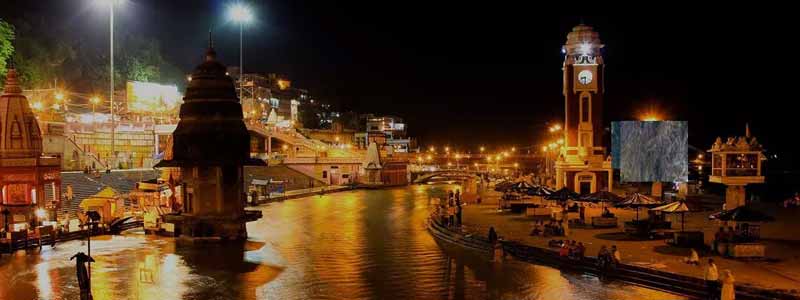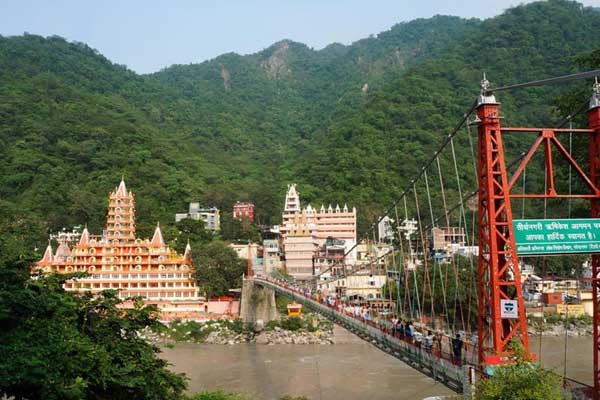Top Tourist Attraction in Haridwar The city of Haridwar welcomes its visitors with chimes of the temple bells and religious chanting of the priests. Famous for being one of the seven holiest places of India, the name of the city Haridwar (Hari ka Dwar) means Gateway to God. The city is also known for the “Panch Tirth (five pilgrimages)” which includes Gangadwara(Har Ki Pauri), Kushwart (Ghat), Kankhal, Biswas Tirtha( Mansa Devi) and Neel Parvat (Chandi Devi). Other places to visit in Haridwar are religious attractions such as Maya Devi Temple, Darsha Mahadev Temple, and Pavan Dham.
The city also has a replica of the Vaishno Devi temple at Jammu for those who have not been able to visit the temple at Jammu. Adding to the list of places to see in Haridwar is an 8 storey temple dedicated to Bharat Mata. The beauty of this city lies in its blend of being a holy place with a beautiful natural environment. Visitors are awed when they watch the Ganga Aarti in progress especially during the evening.
Other Tourist places in Haridwar include Crystal World with its museums for the kids, Patanjali Yogpeeth for people looking for health improvements. For nature lovers, the city is a paradise, watching exotic migratory birds at Neel Dhara Pakshi Vihar or a jungle safari at Chilla Sanctuary and Rajaji Sanctuary or even enjoying the tranquil beauty of the Ganges from one of the ghats Top Tourist Attraction in Haridwar.

Har Ki Pauri, Haridwar
One of the first places to visit in Haridwar is the holy ghat of Har Ki Pauri – which means Lord Shiva’s steps – located on the banks of the Ganga River. Interestingly, the Vedic literature mentions that Lord Shiva and Lord Vishnu visited this place, and you can also see a large footprint on a wall that is said to be of Lord Vishnu. Also known as Gangadwar, this is the place where the Ganga River first leaves the mountains and enters the plain Top Tourist Attraction in Haridwar.
Har Ki Pauri is considered to be the most sacred ghat in the entire city where the mythological bird Garuda accidentally dropped Amrit (elixir), and it is believed that if you take a dip here, then all your sins get washed away. The Ganga aarti held at the ghat at dusk and dawn attracts devotees in large numbers.
- Location: Kharkhari, Haridwar
- Timings: 24X7 (Ganga Aarti: 5:30 am – 6:30 am and 6 pm – 7 pm)
Mansa Devi Temple, Haridwar
Another popular place to visit in Haridwar is Mansa Devi Temple atop the Bilwa Parvat on the Shivalik Hills, and owing to its location it is also known as the Bilwa Tirth. This Siddh Peeth is dedicated to Goddess Mansa, who is believed to be a form of Goddess Shakti and is said to have been created from Lord Shiva’s mind Top Tourist Attraction in Haridwar.
It is one of the most revered temples in North India as devotees firmly believe that all their wishes are granted by Goddess Mansa (the name of the deity means wish). You can either reach this temple on the hilltop by trekking or by taking the ropeway, which is one of the unmissable things to do in Haridwar.
- Location: Bilwa Parvat, Haridwar
- Timings: 5 am to 9 pm
Chandi Devi Temple, Haridwar
Chandi Devi Temple is another Siddh Peeth dedicated to Goddess Chandi – a form of Goddess Durga and is visited by thousands of devotees to get their wishes fulfilled. This temple is situated atop the Shivalik Hills’ Neel Parvat, which was the mythological battleground where the goddess killed demons Chand-Mund and later, Shumbh-Nishumbh. The temple is believed to have been constructed by the Kashmir King Suchan Singh while the idol was established in the 8th century by Adi Shankaracharya, Top Tourist Attraction in Haridwar.
You can trek to the temple or take the ropeway (Chandi Devi Udankhatola) that offers a bird’s-eye view of Haridwar. Near this temple lies another popular religious site – Gaurishankar Mahadev Temple that is dedicated to Lord Shiva.
- Location: Neel Parvat, Haridwar
- Timings: 7 am to 7 pm
Kankhal, Haridwar
Kankhal, one of the Panch Tirths in Haridwar, is a small colony that is home to the renowned Daksha Mahadev Temple and Maa Anandamayi Ashram. The former is dedicated to Lord Shiva and is visited by innumerable devotees, especially during the holy month of Sawan. The latter is a spiritual centre, built in honour of the Bengali mystic leader Maa Anandamayi, Top Tourist Attraction in Haridwar.
Kankhal is also home to the holy ghat of Kushavarta, which is one of the Panch Tirths and the famous Patanjali Yog Peeth that is probably the largest yoga centres in the world. Pardeshwar Mahadev Temple in Harihar Ashram, located on Kankhal Road, is famous for the unique Parad Shivalinga that is made from 151 kg mercury.
- Location: South Haridwar
- Timings: 24X7
Maya Devi Temple, Haridwar
Completing the trio of Siddh Peeths in Haridwar is Maya Devi Temple, which is dedicated to Goddess Maya, who is the main deity of Haridwar and in reverence, the city was earlier known as Mayapuri. As per mythological literature, the temple has been built on the site where Goddess Sati’s heart and navel fell.
It is one of the oldest temples in the entire country that was built in the 11th century on Har Ki Pauri Ghat. Although the temple is visited by hundreds of devotees daily to seek the goddess’ blessings and get their wishes granted, the footfall increases immensely during Navratri and Kumbh Mela.
- Location: Birla Ghat, Haridwar
- Timings: 7 am to 7 pm
Shantikunj, Haridwar
One of the most popular spiritual and moral enlightenment centres in the world is Shantikunj in Haridwar. Established in 1971, it is the headquarters of All World Gayatri Pariwar (AWGP) that has millions of followers across the world. The centre propagates national integration as well as cultural and ethical values apart from spiritual and moral upliftment. Shantikunj also has a research institute (Brahmavarchas Shodh Sansthan) and a residential university (Dev Sanskriti Vishwavidyalaya).
This must-visit attraction has been visited by a number of world-renowned personalities, including Dalai Lama. You can also stay here for free for up to two days, during which you need to take part in all their daily activities, including bhajans and aartis.
- Location: Motichur, Haridwar
- Timings: 24X7
Sapt Rishi Ashram, Haridwar
Sapt Rishi Ashram, located on the banks of the river, is one of the popular places to visit in Haridwar. Along with Hindu devotees, the ashram sees a high footfall of visitors looking for a peaceful site for meditation and yoga. The tranquil ambience of this place is so perfect for meditation that it even attracted the renowned seven sages, and thus got its name – sapt means seven and rishi means sage.
As per mythology, Kashyapa, Vashishta, Atri, Vishwamitra, Jamadagi, Bharadwaja and Gautam – the seven sages were meditating along the banks but were getting disturbed by the sound created by the flowing river and thus captured it. Later, Ganga split the flow into seven streams (Sapt Sarovar) to minimise the noise of gushing water.
- Location: Motichur, Haridwar
- Timings: 24X7
